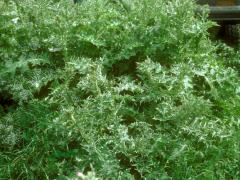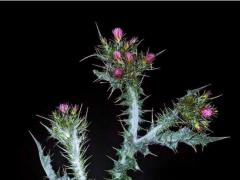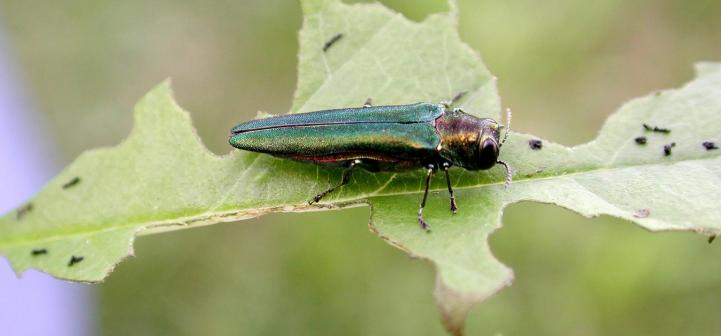Invasive Species: Carduus tenuiflorus, Slenderflower Thistle
Slenderflower thistle is an herbaceous winter annual or biennial plant that invades disturbed areas. The most serious infestations occur in the Pacific coastal states, but slenderflower thistle also occurs sporadically in the eastern United States. Plants grow up to 6 ft. (1.8 m) tall with single or multiple spiny stems with wings arising from the base of the spines. Stem wings can be up to 0.4 in. (10 mm) wide. Leaves are deeply lobed and also very spiny. The small flower heads (less than 1 in. [2.5 cm] long) are slender, purple, and lack stalks. Flowering occurs from May to July. Slenderflower thistle invades pastures, old fields, vacant lots, and other disturbed areas. Its presence reduces the forage productivity of pastures. Slenderflower thistle is native to Europe and was recognized as a serious invader in the western United States as early as 1956.
What are invasive species and why should we be concerned about them?
Taxonomy: Scientific and Common Names for This Species
Asterales > Asteraceae > Carduus tenuiflorus W. Curtis
Synonym(s): Italian thistle, winged plumeless thistle
Carduus tenuiflorus – USDA PLANTS Profile
Distribution Maps
Slenderflower thistle – The reported distribution of this invasive species across the United States. (Source: Invasive Plant Atlas of the United States)
Up-to-the-minute distribution maps and why they are important
Reporting This Invasive Species
What is the best way and place to report the occurrence of an invasive species?
How to report an invasive species sighting to EDDMapS – Early Detection & Distribution Mapping System
EDDMapS – Report an invasive species to EDDMapS
Cooperative Extension Offices – Find your local Cooperative Extension office on this map provided by USDA
How to Identify
This invasive species can be identified by looking for the characteristics described in the paragraphs that follow.
Plant
Slenderflower thistle is an herbaceous winter annual or biennial invasive plant that grows up to 6 ft. (1.8 m) tall with single or multiple spiny stems with wings arising from the base of the spines. Stem wings can be up to 0.4 in. (10 mm) wide.
 |
|
| Evelyn Healy, University of California – Davis, bugwood.org | bugwood.org |
Foliage
Leaves are deeply lobed and also very spiny.
 |
 |
| Eric Coombs, Oregon Department of Agriculture, bugwood.org | Eric Coombs, Oregon Department of Agriculture, bugwood.org |
Flower
The small flower heads (less than 1 in. [2.5 cm] long) are slender, purple, and lack stalks. Flowering occurs from May to July.
 |
 |
| Joseph M. DiTomaso, University of California – Davis, bugwood.org | Joseph M. DiTomaso, University of California – Davis, bugwood.org |
Fruit
| bugwood.org | bugwood.org |
Native Thistle Species That Can Resemble Slenderflower Thistle
Centaurea americana, American star-thistle – Images at invasive.org
 |
 |
| Karan A. Rawlins, University of Georgia, bugwood.org | Karan A. Rawlins, University of Georgia, bugwood.org |
– Images at invasive.org
| bugwood.org | bugwood.org |
Additional Images for Slenderflower Thistle
Slenderflower thistle – Images at Invasive.org
Learning Resources for Slenderflower Thistle
Additional Information, Biology, Control and Management Resources
Control and management recommendations vary according to individual circumstances. Location, habitat, weather, and a variety of other conditions are factors that help determine the best treatment choice. To find the safest and most effective treatment for your situation, consult your state’s land-grant institution. If you will use chemicals as part of the control process, always refer to the product label.
United States Land-Grant University System – Find your land-grant university’s College of Agriculture, Cooperative Extension Service, or other related partner on this map provided by USDA.
Jepson Herbarium – University of California
Plant Profiles – Cal-IPC
Noxious weeds – King County
Slenderflower Thistle (Winged Slender or Seaside Thistle) – BUGWOOD Wiki
Slenderflower thistle – Invasive Plant Atlas
